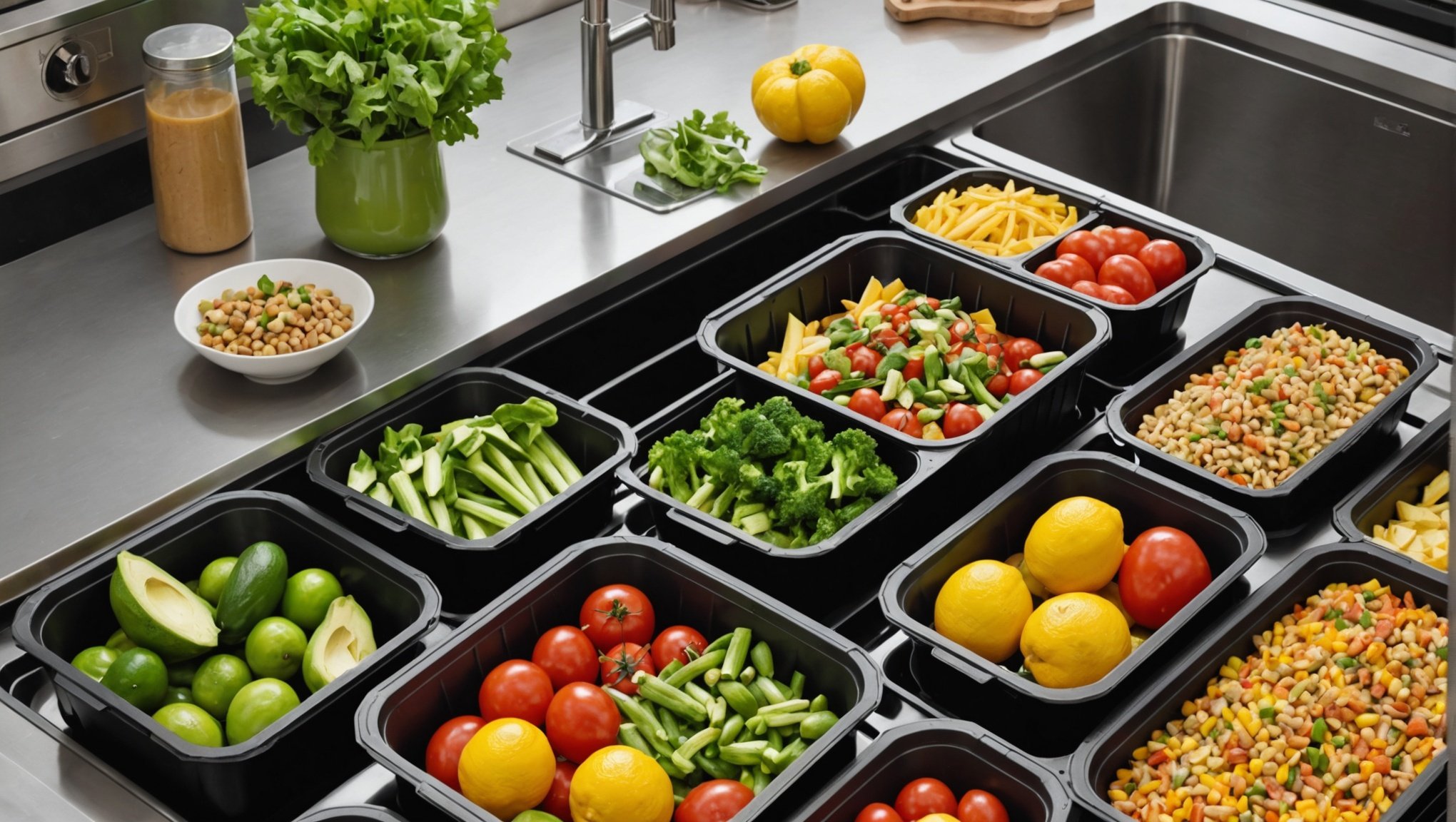Transforming your kitchen isn’t just about aesthetics; it’s a chance to cultivate healthier eating habits. Implementing a waste sorting system can dramatically shift how you perceive food. By consciously separating waste, you gain insight into your eating patterns, fostering mindfulness. This simple change encourages the selection of fresh, whole ingredients, reducing reliance on processed options. Discover how this practical approach not only minimizes waste but also inspires a healthier lifestyle.
Benefits of a Waste Sorting System
Implementing a waste sorting system in your home or business can significantly enhance your sustainable eating practices. By sorting waste, you can gain a clearer understanding of the types and quantities of food you dispose of, leading to more mindful food choices. This awareness can promote healthier eating habits, as you become more conscious of purchasing and consuming only what is necessary.
Also read : Top Tips to Keep Your Bread Box Mold-Free: Expert Strategies for Freshness!
The environmental impact of waste sorting is profound. By reducing kitchen waste, you contribute to decreasing the volume of waste sent to landfills, which in turn lowers greenhouse gas emissions. This practice supports a cleaner environment by facilitating recycling and composting efforts, ultimately conserving natural resources and reducing pollution.
Furthermore, waste sorting encourages mindful eating by highlighting the importance of valuing food. When you sort waste, you become more attentive to the origins and lifecycle of your food, fostering a deeper appreciation for its production and the resources involved. This connection can lead to more thoughtful consumption and a reduction in food waste.
Have you seen this : Top Tips to Keep Your Bread Box Mold-Free: Expert Strategies for Freshness!
In conclusion, the benefits of waste sorting extend beyond mere environmental considerations. It encourages healthier eating habits and promotes a sustainable lifestyle, offering a holistic approach to managing resources responsibly.
Setting Up a Waste Sorting System
Creating an efficient waste sorting setup in your kitchen involves thoughtful planning and organization. A well-structured system not only aids in waste management but also enhances the overall functionality of your kitchen space.
Essential Components of a Waste Sorting System
To establish a successful waste sorting system, it is crucial to include several key components:
- Multiple Bins: Allocate separate bins for recyclables, compostables, and general waste. This allows for easy sorting and ensures that different waste streams are managed appropriately.
- Clear Labelling: Clearly label each bin to avoid confusion and ensure that waste is placed in the correct container. This can significantly improve the efficiency of your waste sorting setup.
- Accessible Location: Position the bins in a convenient location, ideally near the kitchen work area, to encourage regular use and streamline the sorting process.
Tips for Organizing Your Kitchen Space
A well-organized kitchen facilitates effective waste sorting. Consider the following:
- Utilize Vertical Space: Install shelves or hooks to store kitchen tools, freeing up counter space for waste bins.
- Designate Zones: Create specific areas for food preparation, cooking, and waste disposal to minimize clutter and improve workflow.
By implementing these strategies, you can enhance your kitchen’s efficiency and contribute to sustainable waste management practices.
Healthy Eating Choices Inspired by Waste Sorting
Understanding the impact of waste sorting can inspire more sustainable choices in your daily meals. By focusing on food waste reduction, you can create meals that are both nutritious and environmentally friendly.
Consider using leftovers creatively to minimize waste. For example, transform last night’s roast vegetables into a hearty soup or a vibrant salad. This not only reduces waste but also ensures that you are making the most of your ingredients, promoting healthy eating.
Incorporating seasonal and local ingredients into your meals can further enhance sustainability. Seasonal produce is often fresher, more nutritious, and requires less transportation, reducing your carbon footprint. Visit local farmers’ markets to find fresh, seasonal ingredients that inspire new meal ideas.
Adopting cooking techniques that emphasize healthy eating can also contribute to waste reduction. Techniques such as steaming, grilling, or baking preserve nutrients and require less oil, promoting a healthier lifestyle. Additionally, consider batch cooking to prepare meals in advance, reducing the temptation to order takeout and decreasing food waste.
By integrating these practices, you can make informed decisions that benefit both your health and the environment, aligning with the principles of waste sorting and sustainable living.
Case Studies: Success Stories of Waste Sorting
Exploring waste sorting case studies reveals inspiring real-life examples that showcase the transformative power of waste management. These stories highlight how individuals, communities, and businesses have embraced waste sorting to achieve remarkable results.
Individual Stories of Health Improvement
Individuals have experienced significant health benefits by adopting waste sorting practices. For instance, a family in Manchester began sorting their kitchen waste and noticed a marked improvement in their eating habits. By becoming more conscious of their food disposal, they reduced processed food consumption and increased their intake of fresh produce, leading to better overall health.
Community Programs Encouraging Waste Sorting
Many community initiatives have successfully promoted waste sorting. In Brighton, a neighbourhood program encouraged residents to separate waste, resulting in a 30% reduction in landfill contributions. This initiative not only decreased environmental impact but also fostered a sense of community pride and cooperation.
Businesses Implementing Waste Sorting Systems
Businesses, too, have reaped the benefits of waste sorting. A London-based restaurant implemented a comprehensive waste sorting system, which led to a 40% reduction in food waste. This not only enhanced their sustainability efforts but also improved their bottom line by reducing waste disposal costs.
Tools and Resources for Effective Waste Sorting
To enhance your waste sorting efforts, utilising the right tools and resources can make a significant difference. Integrating technology and practical gadgets into your routine not only simplifies the process but also promotes a more sustainable lifestyle.
Recommended Apps for Tracking Food Waste and Meal Planning
Several apps can assist in tracking food waste and planning meals more effectively. Apps for sustainability, like OLIO and Too Good To Go, help reduce waste by connecting users with surplus food. These platforms encourage sharing and purchasing excess food items, preventing them from ending up in landfills. Additionally, meal planning apps such as Mealime and Paprika help organise shopping lists and recipes, ensuring you buy only what you need.
Kitchen Gadgets That Facilitate Waste Sorting
Investing in kitchen resources designed for waste sorting can streamline the process. Compost bins with odour filters and multi-compartment waste bins offer convenient solutions for separating recyclables, compostables, and general waste. These gadgets make it easier to manage different waste streams efficiently.
Online Resources for Sustainable Eating
Online platforms provide valuable insights into sustainable eating practices. Websites like Eat Well Guide and Sustainable Table offer tips on sourcing local, seasonal ingredients and reducing food waste. Engaging with these resources can inspire more informed and eco-friendly food choices.
Overcoming Challenges in Waste Sorting
Navigating waste sorting challenges can be daunting, yet addressing these obstacles is crucial for effective waste management. Understanding and overcoming these common issues can significantly enhance your waste sorting efforts.
Common Misconceptions About Waste Sorting
One prevalent misconception is that all plastics are recyclable. In reality, not all types of plastic can be processed in recycling facilities. This confusion often leads to contamination in recycling bins. To combat this, it’s essential to educate yourself on local recycling guidelines, which can vary by region.
Strategies to Maintain a Consistent Waste Sorting Habit
Consistency is key in waste sorting. Establishing a routine can help maintain these habits. Consider setting reminders for waste collection days and regularly reviewing what items go into each bin. Involving family members or colleagues in the process can also foster a collective responsibility towards waste management.
Handling Contamination in Recycling
Contamination is a significant obstacle in recycling. Items like food waste or non-recyclable materials can spoil entire batches of recyclables. To reduce contamination, rinse containers before disposal and be vigilant about what is placed in recycling bins. By implementing these solutions, you can overcome common obstacles and ensure a more efficient waste sorting system.
The Role of Education in Promoting Waste Sorting
Education plays a pivotal role in fostering effective waste sorting habits. By educating family members, you can cultivate a household culture that prioritises sustainability. Teaching the importance of separating recyclables, compostables, and general waste can lead to more environmentally conscious behaviours. When everyone understands the impact of waste sorting, it becomes a shared responsibility.
Community Outreach and Workshops
Engaging in community outreach and workshops is an effective way to spread awareness about waste sorting. Local workshops can provide hands-on learning experiences, demonstrating the practical aspects of waste separation. Schools can integrate waste sorting education into their curriculum, empowering students to become advocates for sustainable practices. By learning early, children can influence their families and communities.
Collaborating with Local Organizations
Collaborating with local organisations amplifies the reach of waste sorting education. Non-profits and environmental groups often have resources and expertise to conduct educational programs. Partnering with these organisations can enhance community engagement and provide valuable insights into effective waste management strategies. Through joint efforts, communities can develop robust systems that support sustainable living.
Visuals and Infographics to Enhance Understanding
Incorporating waste sorting visuals and infographics can significantly enhance understanding and engagement in waste management practices. These educational tools simplify complex information, making it more accessible and memorable.
Creating Infographics for Waste Sorting Benefits
Infographics are powerful tools for illustrating the benefits of waste sorting. They can visually represent data such as reduced landfill contributions, decreased greenhouse gas emissions, and improved recycling rates. By using clear graphics and concise text, infographics can effectively communicate the positive impact of waste sorting on the environment and health.
Visual Guides for Setting Up a Waste Sorting System
Visual guides are invaluable when setting up a waste sorting system. They provide step-by-step instructions, helping users to organise their kitchen space efficiently. Illustrations showing the placement of bins, clear labelling, and accessible locations can simplify the setup process, ensuring that waste sorting becomes an intuitive part of daily routines.
Case Study Infographics for Community Initiatives
Infographics can also highlight successful community initiatives in waste sorting. By showcasing real-life examples, such as neighbourhood programs or business efforts, these visuals can inspire others to adopt similar practices. Infographics can present data on waste reduction achievements, fostering a sense of community pride and encouraging widespread participation in sustainable practices.






